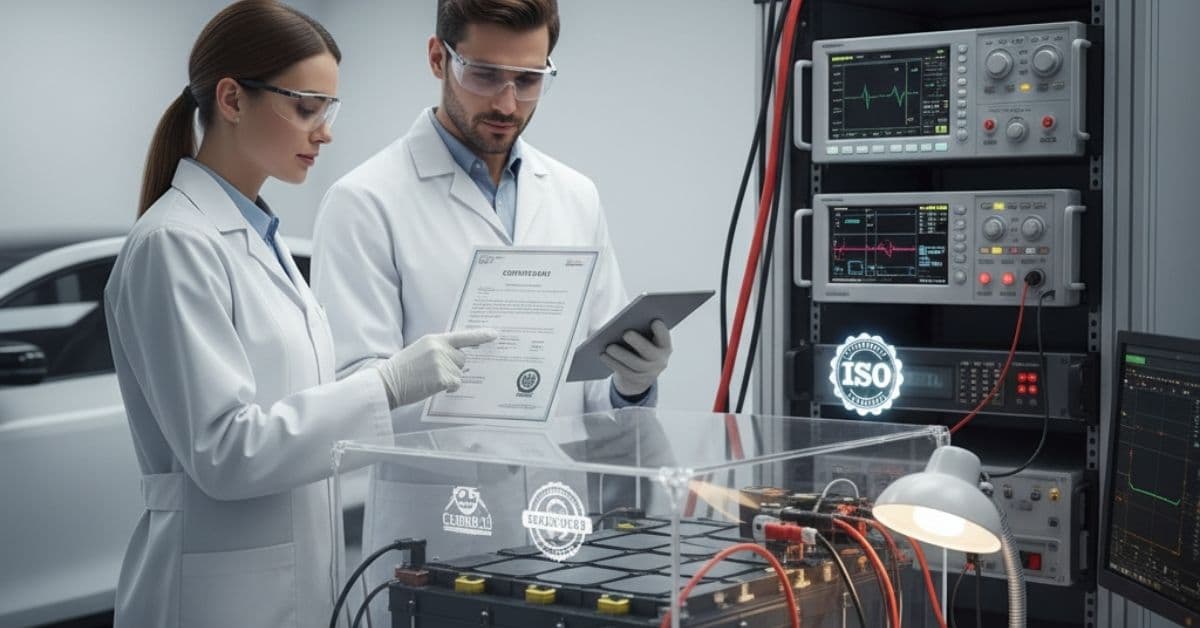Major organizations develop standards and certification programs that lithium-ion EV battery cells and packs must meet:
UNECE (United Nations Economic Commission for Europe): Issues regulations like ECE R100 and ECE R136, which cover the safety and electric power train requirements for vehicles, including battery systems, particularly relevant for the European market.
Underwriters Laboratories (UL): Provides essential safety standards for the North American market, such as UL 2580 (Batteries for Use in Electric Vehicles) and UL 1642 (Lithium Batteries, for cells).
International Electrotechnical Commission (IEC): Develops global technical standards like the IEC 62660 series (for secondary lithium-ion cells for propulsion of electric road vehicles) and the IEC 62133-2 (safety requirements for portable sealed secondary lithium systems, often referenced).
International Organization for Standardization (ISO): Publishes test specifications like the ISO 12405 series (test specification for lithium-ion traction battery packs and systems).
United Nations (UN): The UN 38.3 standard is a mandatory global requirement for the safe transport of all lithium-ion batteries, including those for EVs.
Why Standardization Is So Important
Imagine a world where every phone charger was different. You’d have to buy a new charger for every phone, and you could never borrow a friend’s. That’s what the EV world would be like without standards.
1. Safety First
This is the most important reason for standardization. Lithium-ion batteries store a huge amount of energy. If they are not designed and tested correctly, they can overheat, catch fire, or even explode. Standards set a baseline for safety tests, such as how a battery performs after being crushed, overcharged, or subjected to extreme temperatures.
2. Interoperability
Standardization ensures that a battery from one company can work with a car from another. This is crucial for the global supply chain, where automakers often get their batteries from third-party suppliers. It also allows for technologies like battery swapping, where a driver can quickly exchange a drained battery for a fresh one, which is key for speeding up charging.
3. Cost Reduction
When everyone follows the same rules, manufacturers can use the same tools and processes. This makes production more efficient and helps bring down the cost of batteries, which is the single most expensive part of an EV.
4. Trust and Reliability
When a battery has a certain certification, it means it has passed a tough set of tests by a third party. This gives both carmakers and consumers confidence that the product is reliable and will perform as expected.
Who Sets the Standards?
There are many organizations, both public and private, that create and enforce these rules. Here are some of the most important ones.
1. International Organizations
These groups work to create a common set of standards that can be used all over the world.
- International Electrotechnical Commission (IEC): The IEC is a key player in this space. Its Technical Committee 69 (TC 69) and TC 21 specifically work on standards for electric road vehicles and batteries. IEC standards like IEC 62660 are used to test the performance and safety of lithium-ion cells for EV propulsion.
- International Organization for Standardization (ISO): ISO is another global leader. It works closely with the IEC to create standards for road vehicles, including the batteries they use. ISO 12405 specifies test procedures for lithium-ion battery packs and systems for EVs.
2. Regional and National Organizations
While international standards are great, many countries have their own rules.
- Underwriters Laboratories (UL): UL is a well-known U.S.-based safety science company. Its standards, like UL 2580, are often required for batteries and battery packs sold in North America. UL conducts a wide range of tests to make sure products are safe.
- United Nations (UN): The UN has a crucial standard for the transportation of lithium-ion batteries. UN38.3 is a mandatory certification for shipping batteries by air, sea, or land. It includes tests for things like vibration, shock, and extreme temperatures to ensure the battery will not catch fire or explode during transport.
Key Certification Programs and Their Purpose
Passing a standard is one thing; getting certified is another. Certification is the official proof that a product has met the required standard.
1. UN38.3
This is arguably the most important certification for any company that wants to ship batteries. It proves that the battery is safe to transport. Without it, you cannot ship a battery anywhere in the world.
2. UL Certification
This is a must-have for any company that wants to sell batteries in the North American market. A UL mark on a product means it has been tested and certified by UL to meet a certain safety standard.
3. CE Marking
This is a self-declaration by the manufacturer that a product meets the health, safety, and environmental standards of the European Union. While a manufacturer can self-declare, they must be able to provide proof of compliance, which usually involves a lot of testing.
4. CB Scheme
This is an international program that allows a manufacturer to get one certification and have it recognized in many different countries. It makes it much easier for a company to sell its products globally.
The Bigger Picture: Standardization and the EV Lifecycle
Standards don’t just apply to new batteries. They are becoming more and more important for the entire life of an EV battery.
1. Second-Life Batteries and Recycling
A typical EV battery is “retired” when its capacity drops to about 70-80% of its original life. While this is not enough for a car, it is still perfect for other uses, like storing solar power for a home or business. This is called a “second-life” application.
- Safety and Performance: New standards are being developed to ensure that these “used” batteries are safe to use in new applications. They must be re-tested to make sure they can still work without problems.
- Recycling: When a battery has no more useful life, it must be recycled to recover valuable materials like lithium, nickel, and cobalt. Standards are being created to ensure that this recycling process is safe and efficient.
2. Charging and Communication
Standardization also plays a huge role in the charging experience.
- Charging Plugs: Have you ever noticed that a Tesla has a different charging plug than other EVs? This can be confusing for drivers. Standards like the Combined Charging System (CCS) are working to make all charging plugs the same, which will make it easier for people to own and charge an EV.
- Smart Charging: Standards are being developed for “smart charging,” where the car and the charger talk to each other to decide the best time to charge. This helps to put less stress on the power grid and saves money for the car owner.
Case Study: A Manufacturer’s Journey
To give you an idea of how this all works in the real world, let’s look at a hypothetical company, “GreenVolt Batteries,” that wants to sell its EV battery pack in the U.S. and Europe.
- Safety Testing: GreenVolt’s engineers first design the battery to meet the strict requirements of international standards like IEC 62660. They then send a sample to a lab to be tested against a U.S. standard like UL 2580. The tests are tough and include things like a crash test, a fire test, and a short-circuit test.
- Getting Certified: After the battery passes all the tests, UL gives GreenVolt a certification. This allows GreenVolt to put a UL mark on its battery pack.
- Shipping to Europe: Now, GreenVolt needs to ship its battery to a car manufacturer in Germany. To do this, it must prove that the battery is safe to transport. It sends a sample to a lab to be tested against UN38.3. Once it passes, GreenVolt gets a UN38.3 certification, which is required for shipping.
- Meeting EU Standards: Finally, to sell in the EU, GreenVolt must meet the requirements of the EU Battery Regulation and be able to provide documentation that the battery is safe and sustainable. GreenVolt’s team makes sure its supply chain and manufacturing process are fully compliant.
As you can see, the process is long and difficult. But a company that invests in these standards and certifications is building a trustworthy product that is ready for the global market.
Practical Advice for Professionals and Consumers
- For Car Buyers: When you are looking at an EV, you probably won’t find a list of all the certifications. But you can trust that any major brand, from Ford to Hyundai, has made sure its batteries meet the highest standards. You can also look for third-party battery health certificates from companies like AVILOO when buying a used EV, which give you a clear report on the battery’s condition.
- For Businesses: Don’t think of standards as a burden. Think of them as a roadmap for success. By investing in standards and certifications early, you can avoid costly mistakes, build a safe and reliable product, and gain a major advantage in a very competitive market.
Frequently Asked Questions (FAQs)
What is the most important certification for an EV battery?
logistics and transportation. Without it, you cannot legally ship a battery internationally. For safety, a certification from a well-known lab like UL or the CE mark is essential for consumer trust.
Who pays for the testing and certification?
The company that makes the battery is responsible for paying for all the testing and certification. This is a major cost for a new company, but it is a necessary part of bringing a product to market.
Do these standards prevent a car from having a battery fire?
While no standard can prevent every single problem, they dramatically reduce the risk of a battery fire. They ensure that the battery has been tested under extreme conditions, and they require safety features to be built into the battery’s design.
Are standards for recycling and “second-life” batteries a big deal?
Yes, they are. They are critical for creating a “circular economy” for EV batteries. By having recycling rules, we can make sure that valuable materials are not wasted, and by having rules for second-life batteries, we can get the most use out of a battery before it is recycled.
Conclusion
Standardization and certification programs for lithium-ion EV batteries are the bedrock of the global electric vehicle industry. They are a universal language of safety, quality, and performance that allows for a smooth, global supply chain. While they may not be the most exciting part of the EV revolution, they are one of the most important. As we move closer to a fully electric world, these standards will continue to evolve, becoming even more important for a future that is not just clean but also safe, reliable, and efficient.







